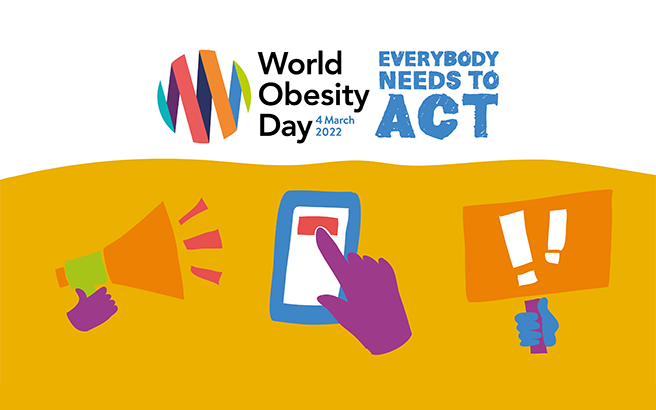As we well know, obesity and overweight are a risk factor for 12 different types of cancer. As the world marks World Obesity Day 2022, we take a closer look at how the rising trends of obesity could impact cancer prevalence around the world and what can be done to address this worrying trend.
The worldwide prevalence of obesity nearly tripled between 1975 and 2016 and it continues to rise in most countries. The World Obesity Atlas 2022, published by the World Obesity Federation today, predicts that 1 billion people globally, including 1 in 5 women and 1 in 7 men, will be living with obesity by 2030.
Governments around the world have been slow in honouring their commitments to tackle obesity. Countries will not only miss the 2025 WHO target to halt the rise in obesity at 2010 levels for both adults and children, but the number of people with obesity is on course to double across the globe. Childhood obesity is particularly concerning, as it is likely to carry over into adulthood. The impact of the COVID-19 pandemic on obesity prevalence in children is also worrying – as some countries are producing evidence that in the past two years children and adolescents – particularly vulnerable children – were less likely to be physically active, and more likely to eat junk foods.
Looking at the connection between cancer and obesity, our Third Expert Report found that maintaining a healthy weight throughout life is one of the most important ways to protect against cancer. Therefore, interventions at both population and individual level to reduce obesity and to sever the obesity–cancer link are critical for cancer control.
So, what can be done?
To reverse these trends in obesity and break the connection to cancer risk, we must focus on implementing a range of policies to change our environments. This is not a new or novel idea, however, this simple message often sits at odds with public and political discourse – where overweight and obesity is often blamed on the individuals, and is associated with deeply ingrained weight stigma, compounded by other inequalities. There are some exceptions.
Overweight and obesity have complex causes that are largely related to what is known as obesogenic environments – which refers to physical environments that encourage unhealthy diets and physical inactivity, such as proliferation of cheap, readily available junk foods.
Digital environments matter too – as there are increasingly more sophisticated and targeted ways of advertising junk foods online, such as through food delivery apps and social media influencers. Some limits have been imposed to this kind of advertising on more traditional media, such as TV – although these vary in strength across countries – but these small decreases on traditional media are likely to be offset by huge increases in digital environments.
We are seeing more and more focus and activity on marketing and acknowledgement of the digital influences. Only last month, a new WHO and UNICEF report highlighted the aggressive practices deployed to market infant formula at the expense of breastfeeding. Breastfeeding not only promotes the healthy growth and development of children and protects against overweight and obesity but also cancer in later life, as well as protecting the mother against breast cancer.
Where do we go from here?
Whilst we are seeing small signs of progress to change our environments, and to tackle weight stigma that prevents people living with overweight and obesity to live their lives fully, more needs to be done. We know that a range of policies are needed, rather than isolated pockets of action. The 2022 WHO Executive Board has adopted recommendations and targets for halting the raise in obesity, which is hoped will provide an impetus for countries to act. We are pushing for a Global Obesity Action Plan to be developed at the next World Health Assembly in May, to draw together more action and surveillance to ensure governments are held accountable to these commitments.
There are some encouraging opportunities that need to be harnessed to drive action. For instance, at European level, the EU Cancer Beating Plan puts an important emphasis on prevention, through policies such as restricting marketing of unhealthy foods. In light of continued aggressive marketing techniques, we still support the strengthening of the protection of children from the excessive marketing of nutritionally poor food as a key priority – following on from our call with 19 other organisations for a blueprint Directive that would use EU powers to regulate all types of marketing.
Furthermore, the evidence base of what works is expanding. In the UK, a ban on marketing of junk foods on public transport in London is the latest example of how bans in unhealthy food marketing work – by creating healthier environments. We remain hopeful that a pioneering new digital marketing regulation will be enacted in the UK, despite fierce industry opposition. Measures like these will contribute to healthier environments for people to make choices in.
Lastly WCRF International remains committed to studying more closely the links between obesity and cancer, and how obesity plays out through the life-course through its Global Cancer Update Programme, and the policy response that will follow.
